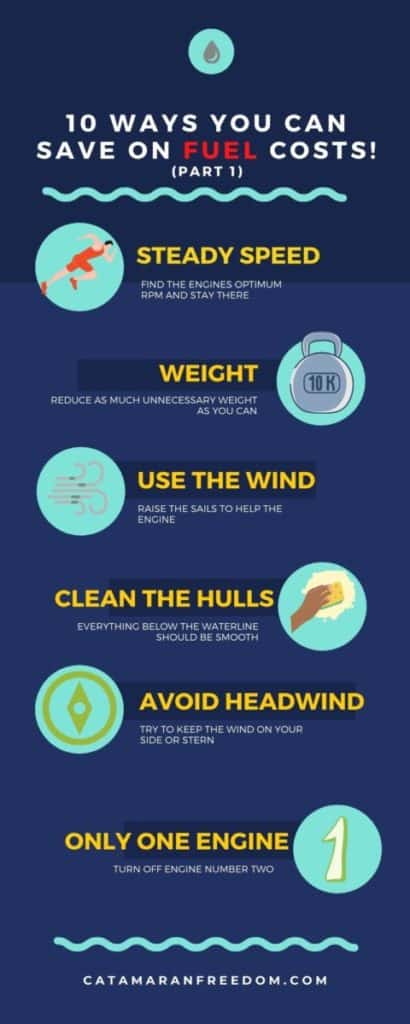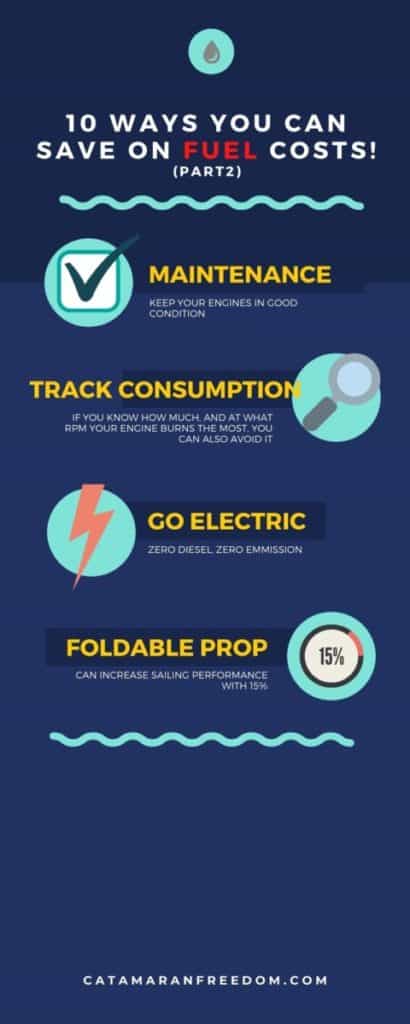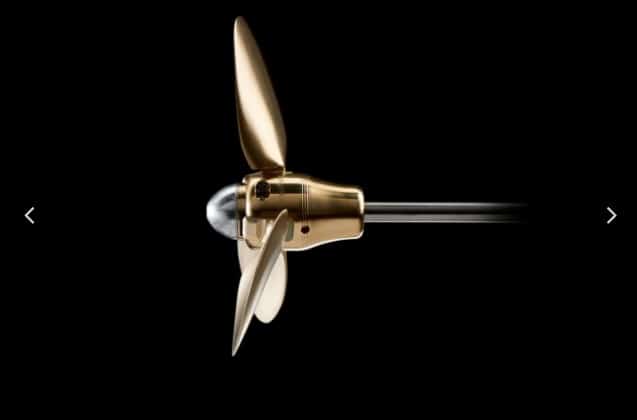As an Amazon Associate, we earn from qualifying purchases. We may also earn commissions if you purchase products from other retailers after clicking on a link from our site.
As much as I love turning off the engine and only using the sails, sometimes I have found myself in situations where I was forced to rely on engine power. Situations like a brewing storm or the need to head straight into the wind.
Electric instead of combustion engines? Read this article!
Understanding catamaran fuel efficiency and how far you can go on a certain amount of fuel is vital to keep you away from bad situations.
Catamarans are more (fuel) efficient than a monohull (regular sailboat). During calm conditions, while powering under one engine, fuel consumption is between 0.3 gallons per hour (gph, of diesel) and 1.1 gph according to the data collected.
Below I have gathered fuel consumption data from catamaran owners.
| Model | GPH single engine | L/h Single Engine | Time until Empty (h) | Distance until Empty (nm) |
|---|---|---|---|---|
| Catalac 900 | 0.3 | 1.2 | 79 | 476 |
| Gemini 105MC | 0.7 | 2.8 | 49 | 292 |
| Lagoon 380 2008 | 0.6 | 2.1 | 106 | 458 |
| Fountaine Pajot 38 | 1.1 | 4.0 | 50 | 250 |
| Lagoon 440 | 0.5 | 1.9 | 263 | 1106 |
| Lagoon 450 | 1.1 | 4.0 | 250 | 1751 |
What Impacts Catamaran Fuel Economy?
Worth noticing is that going from one engine to two engines doesnt increase your speed by very much, but it doubles your fuel consumption.
Looking at the Lagoon 380, we can see that cruising speed with one engine is 4.3 kts at a fuel consumption of around 2.1 L per hour.
Turning on engine number two will give us seven kts and fuel consumption of 4 L per hour. That’s actually a pretty good “return on investment” since the Catalac only gets one kts of extra speed while doubling fuel burn. Slowing down will almost always save fuel (source)
Below are more of the data I have collected, let’s take a look at what it says.
| Model | Fuel Capacity (Gal) | Fuel Capacity (L) | Length | Engine Manufacturer | Engine HP | GPH Single Engine | L/h Single Engine | L/h Dual Engine | GPH dual engine (kts) | Single Engine speed (kts) | Double Engine Speed (kts) | Time until Empty (h) | Distance until empty (nm) |
|---|---|---|---|---|---|---|---|---|---|---|---|---|---|
| Catalac 900 | 25.1 | 95 | 30ft | Nanni | 2*14HP | 0.3 | 1.2 | 2.4 | 0.6 | 6 | 7 | 79 | 476 |
| Gemini 105MC | 36 | 136 | 34ft | Westerbeke | 27HP | 0.7 | 2.8 | - | - | 6 | 7 | 49 | 292 |
| Lagoon 380 | 59 | 223 | 38ft | Yanmar | 2*20HP | 0.6 | 2.1 | 4 | 1.1 | 4.3 | 7 | 106 | 458 |
| Fountaine Pajot 38 | 53 | 200 | 38ft | Yanmar | 2*27HP | 1.1 | 4.0 | - | - | 5 | 7 | 50 | 250 |
| Lagoon 440 | 132 | 500 | 44ft | Yanmar | 2*55HP | 0.5 | 1.9 | - | - | 4.2 | 5.5 | 263 | 1106 |
| Lagoon 450 | 264 | 1000 | 45ft | Volvo Penta | 2*55HP | 1.1 | 4.0 | 6 | 1.6 | 7 | 8 | 250 | 1751 |
The conclusion? Speed comes at a premium.
Time until empty
This column is based on the lowest possible fuel consumption with one engine. This is the number of hours that you are able to cruise when starting with full fuel tanks.
Distance until empty
This is how far in Nautical Miles, you are able to sail at cruising speed with one engine.
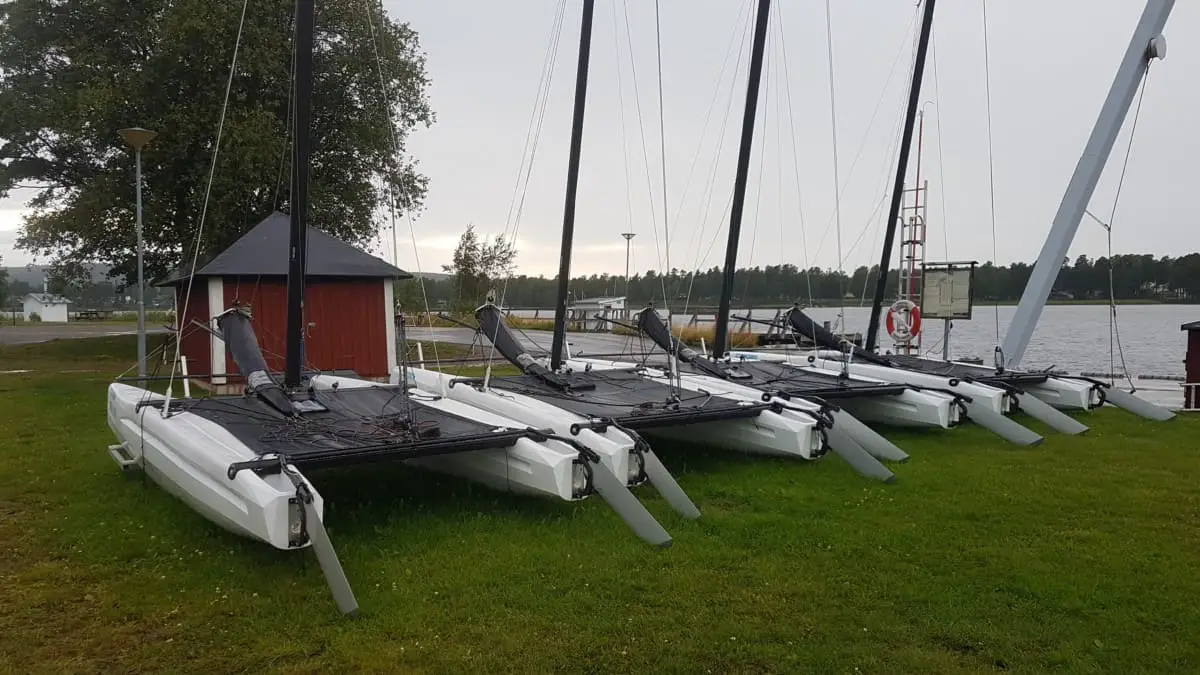
How You Can Improve Sailboat Fuel Efficiency, 10 Tips!
1. Drive Your Boat as You Drive Your Car!
Ok, maybe not as how you actually drive it, but the way your teacher told you to drive it, accelerate slowly, keep a steady throttle, and avoid high revs.
Every engine has an RPM (revolutions per minute) where the engine works the most efficiently; this is the sweet spot where you want to drive the boat.
This is usually around 75-80% of max RPM.
This RPM is not the same as the RPM of your boat’s top speed, but something you should consult is the datasheet of your engine, usually, this is somewhere between 2000- 2900 RPM on diesel, and 3000 – 4000 RPM on a gasoline engine.
Save fuel on your catamaran by slowly accelerating and then keeping your boat in the RPM range stated in the datasheet; this will ensure you get the engine’s optimum efficiency.
Set the RPM, check if the speed is enough to get you where you want in the time you have, if you are ok with the numbers, then just relax and enjoy fuel economy at work (if there’s ever such a thing on a boat…)
2. Keep the Boat Light
Getting a boat to move requires energy, getting a heavier boat to move requires even more energy; keeping your boat light will significantly enhance your fuel economy.
Firstly, the boat will ride higher on the water; this means less underwater drag. Drag is something that dramatically impacts speed; this is one reason why Catamarans are faster than conventional sailboats/monohulls.
Want to know why catamarans are Faster than Sailboats?
Removing weight can be done by only packing the stuff you need for the planned trip, this means that maybe you dont need full tanks of diesel and water, which can be more than a ton of weight.
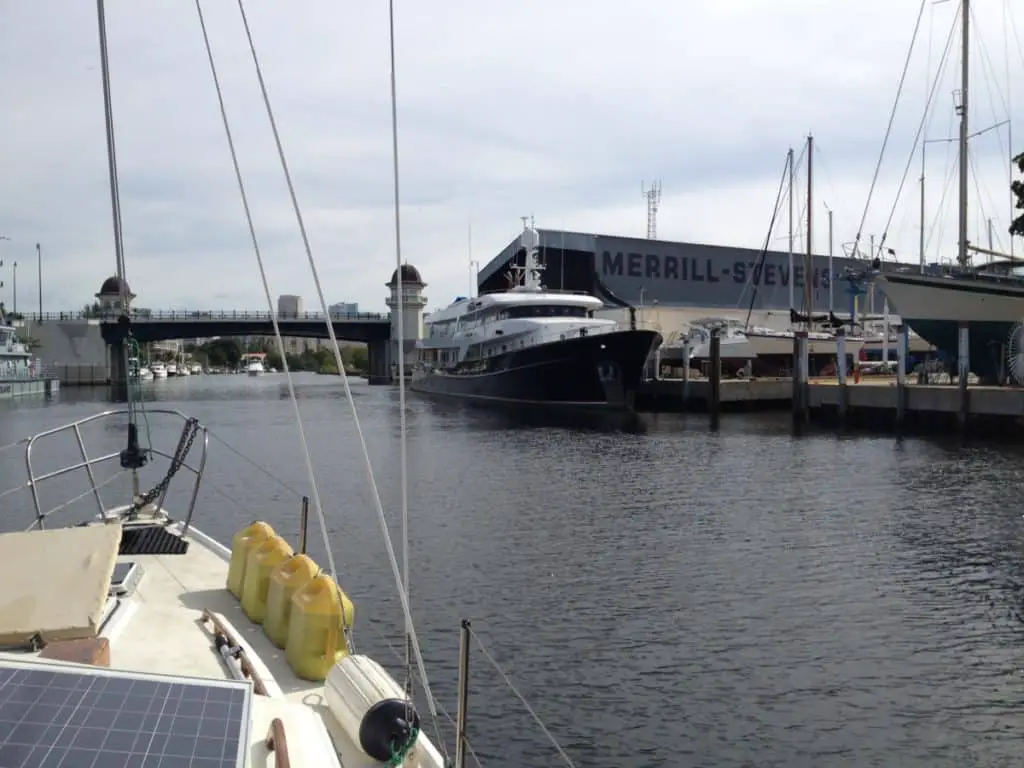
3. Use Your Sails When You Can
Using your sails when motoring will be more than doing just one of the two separately. See it as adding another engine, even if you were only doing 0.5 kts with the sails, these 0.5 kts will make the engine work less hard and thus decrease the amount of fuel needed to travel at the same speed.
Or, you can go faster with the same consumption.
4. Keep Your Hulls and Propeller Clean
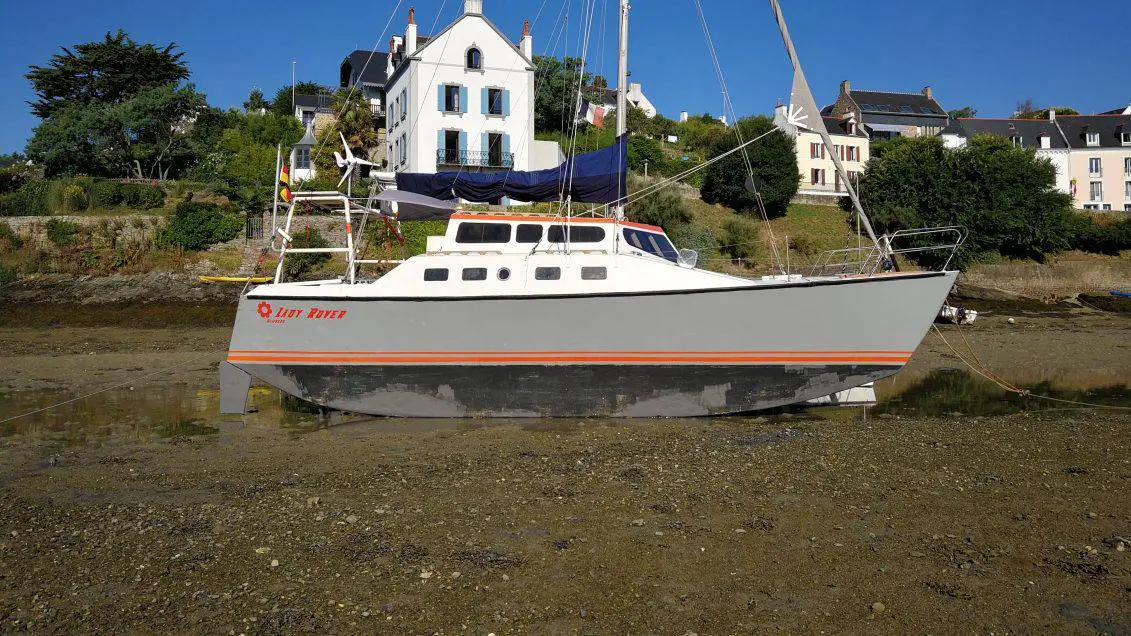
Keeping everything below the waterline clean, just as discussed above, the more surface area under the boat, the more drag.
If the surface is is also uneven due to barnacles, then this also increases drag.
This is important for the boat to move smoothly through the water, but it is also vital for the efficiency of the props.
A prop that is uneven and not in a hydrodynamically good state will be less efficient and will require higher RPMs to move the boat at the same speed as a clean and shiny one.
5. Avoid Going Straight into the Wind
Since a catamaran has such a high profile, it will catch wind even though there are no sails up, so if you head straight into the wind and waves, this will definitely slow down the boat’s speed.
Try going close to shore, where the winds might change in a favorable condition.
6. Running One or Two Engines?
On most catamarans you can run either one or both engines, as stated in the tables above, running two engines is mainly for increasing speed and not fuel efficiency.
You might gain a knot or two, but your fuel cost will almost double in most cases.
If you choose to run your cat only on one engine, there are some significant savings to be done; just make sure you dont overstrain the machinery. Stay within reasonable RPM, as stated by the manufacturer, around 2000-3500. And when you need to go quick, start up the other engine and head for that bridge opening in time 🙂
The last tip on running two engines, try to run them for about the same amount of hours, this means they will be serviced and repaired at around the same time and will be in the same good condition.
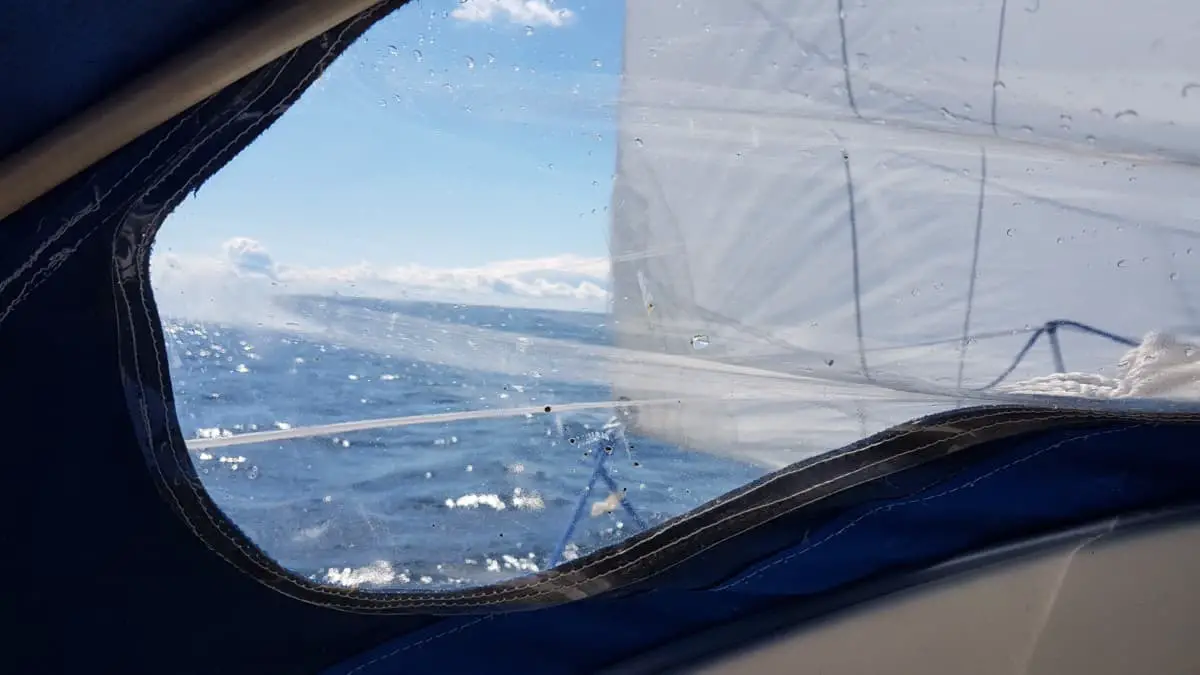
7. Keep Your Engines in Good Shape
Service and maintenance play a part in fuel economy, although not as much as I think many people believe. Some aspects should be kept a careful eye on. Air filters can clog, this means the fuel to air mixture will be wrong, you won’t get the right amount of HP, and you will feel inclined to give it more throttle than needed.
Make sure you service or change your air filters regularly, so they are able to give your engines the fresh air they deserve!
The same applies to fuel filters, although these usually can’t be inspected, make sure you change them according to your service manual, and if your dont have a manual, change it once a year.
Other stuff, such as timing, fuel pumps that you could check, but I would only mess around with those if you suspect that your fuel consumption is abnormally high.
8. Track Your Fuel Consumption
Every engine is a little bit unique if you find a way to measure your fuel consumption and record parameters such as; RPM, amount of diesel consumed, external conditions(waves, winds, currents, etc.), and boat condition (approximate weight).
Then you will know your fuel economy with reasonable precision. This makes trip planning more exact, and you dont have to bring extra fuel(increased weight).
One way to measure is to get a fuel measure instrument such as this one (Amazon link)
9. Using a Foldable prop
The foldable prop is just as it sounds; it is a propeller that can maintain two different positions.
When the prop is folded, the blades go from looking like a fan to something that makes way more hydrodynamical sense.
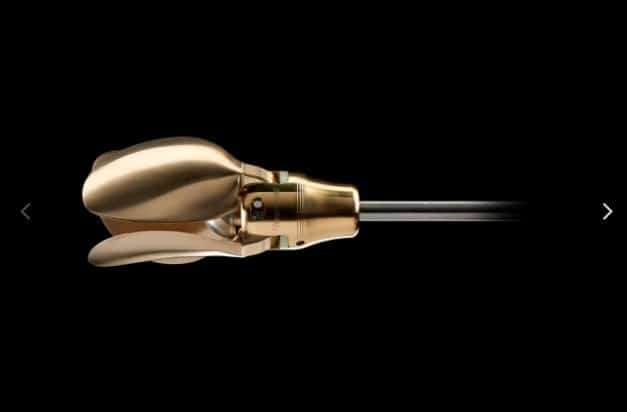
According to flexofold, the folding prop improves sailing performance by around 15%. Another cool thing is that once folded, the risk of getting stuck in a net or fishing line is also reduced.
And when you turn your engine on and start revving it up, the blades fold out, and off you go!
10. Electric conversion
So if you really want to save on diesel costs, then maybe an electric motor is an option. Although running on electricity isn’t free (you will have to charge them somehow), it can be a cheap option in the long run.
Electric conversions are getting more and more common and, therefore, also cheaper. The basic idea is that you switch your diesel engine for an electric motor, and instead of diesel fuel tanks, you will have a lithium battery bank.
These can be charged through solar, wind, or connected to a power source in the marina.
Going electric is different in some ways; let’s take a look. Firstly going electric is a more silent option.
You won’t have the diesel engine’s noise, although you will still have the noise from the prop, so just as an electric car is very silent when moving slow, once you get the boat going up to speed, the sound will also significantly increase.
Another more positive change is that you no longer will have to smell diesel fumes, refill diesel, or service all those parts.
Here is a video of Sailing Uma running their electric motor.
How To Calculate Fuel Consumption
There is an easy way to calculate approximately how much an engine is able to burn at full throttle.
DIESEL ENGINE HP / 16 = Gallons Per Hour
GASOLINE ENGINE HP / 10 = Gallons Per Hour
The calculation is an estimate and is based on full-throttle action, something that hopefully you won’t have to do for much longer than a few minutes at a time.
The calculations will give you an idea of how much fuel you will need.
Are Catamarans More Efficient than other Sailboats?
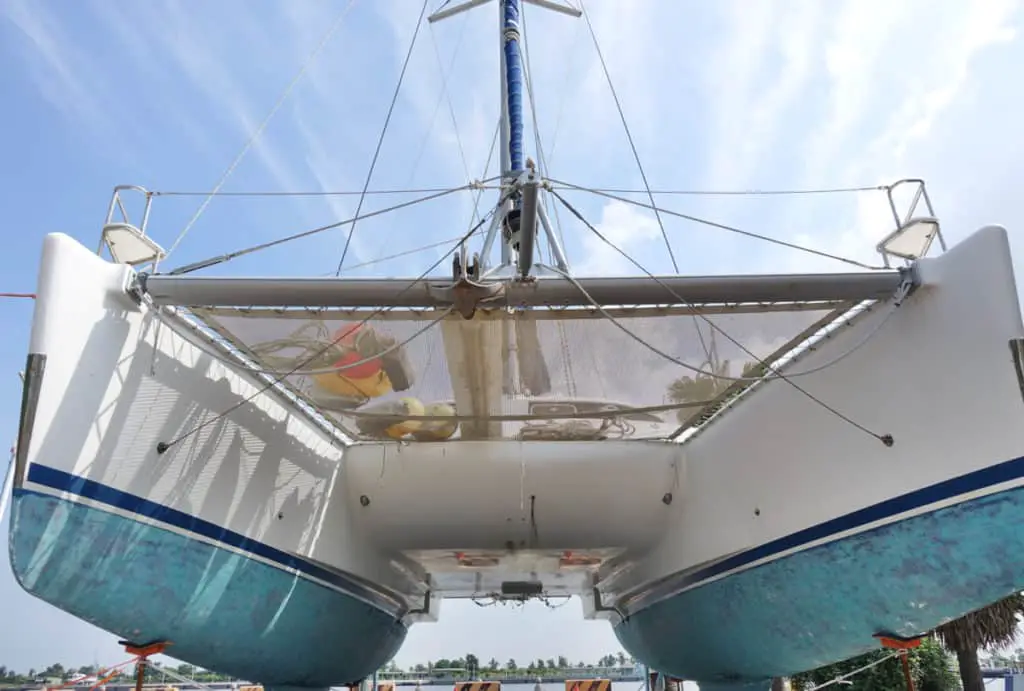
Due to the low drag (small wetted surface), low weight (no keel), and narrow hulls catamarans are more fuel-efficient than a comparable keelboat/monohull. This makes a catamaran more efficient whether under sail or when motoring.
Catamarans will therefore burn less fuel than heavy keelboats.
The reason for the lower drag on a catamaran is that instead of having a big keel and wide hulls, the catamaran has narrow hulls with only a small percentage of the boat below the waterline.
The lower weight is mainly due to not needing a lead keel to balance the forces interacting with the sails. There is no need for a keel since the catamaran is stabilized by having a wide beam(that means the boat has a broad base).
When the wind acts on the sail and pushes it to one side, the force is transferred to the leeward hull(the side that is not faced towards the wind).
A boat that has less drag, and weighs less, will need less energy to move. This means your boat will go faster at the same wind speed or if you are motoring, the ship will use less fuel.
Want to learn why Catamarans are faster than monohulls but slower than Trimarans? Read this!
How To Calculate Fuel Costs
Before you are able to calculate your fuel costs you need to gather some information. These are;
Approximate hours(h) you will run the engine (s)
Approximate hours(h) you will run the generator
Gallons per hour, gph, Generator
Gallons per hour, gph, engine
Price of fuel
Once you have gathered the information you can continue to the next step.
(Engine time in hours * gph Engine) * Price of Fuel = Cost of Engine Fuel
(Generator time in hours * gph Generator) * Price of Fuel = Cost of Generator Fuel
Cost of Engine Fuel + Cost of Generator Fuel = Total Fuel Cost
This is a basic equation you can use when summing up the total cost of your fuel usage. You have to take into consideration different fuel costs if you’re using a standalone gasoline generator.
If you dont have a standalone generator, but you need more electricity I can recommend this one from Honda, it is the same one that I used when I was sailing the Caribbean, it is not the most high-end, but it did what it was supposed to.
Link to Amazon (actually they do not seem to have the one I used, but this looks similar)
Why Do Catamarans Have Engines?
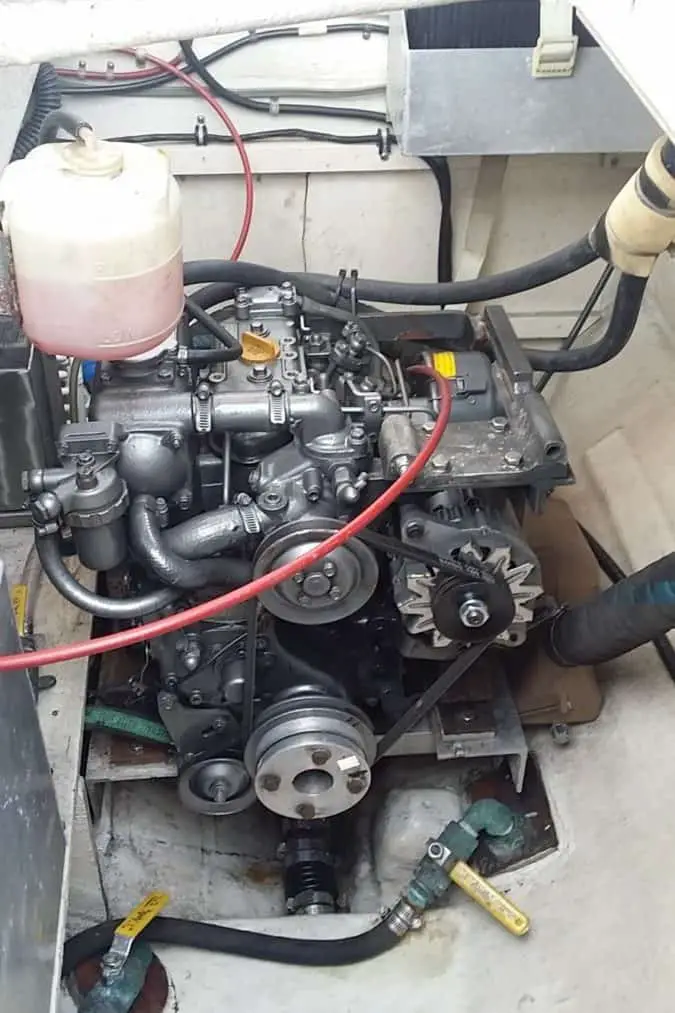
Sailboats have diesel or gasoline engines for a few reasons; to maneuver in and out of a marina, travel when there is no wind, generate electricity, and increase speed when there is little wind.
You might think that having an engine on a sailboat is unnecessary, you have the sails, right?
Well, sailing is fantastic, but it is tough to sail in a confined area such as in a marina or through a tight section through a canal.
If you want to go upwind, many times on a catamaran, it is much faster and more comfortable to motor straight into the wind instead of tacking (turning from one side to another).
Another aspect is when there is wind but only enough for maybe 1-2 knots; then, you can combine motoring with sailing to make the boat faster and more efficient.
How Long Can You Run The Engine on full throttle?
This is a question I sometimes get; there are different ways to answer this.
The longest time you can continuously run your diesel or gasoline engine on full throttle is until it either overheats, runs out of gas, or gets destroyed.
That’s the short answer; the long answer is that it depends on the engine’s condition, the load on the engine, and how good is the cooling
Let’s start by looking at engine condition. If you want to get the maximum possible horsepower out of your engine for the most extended amount of time you should know that it’s going to take its toll on the engine.
This is not something I would recommend if the engine is something that you are dependent upon working,
A well-maintained diesel or gasoline engine can go for days on full throttle as long as the engine load is balanced, hindering it from over-revving and causing it to break.
This is under the assumption that there is necessary cooling to the engine, which is not always the case if you are talking about a catamaran or any other engine that is in confined spaces and made for reasonably low RPM.
If all of those criteria are met, it will probably run until there’s no more diesel in the tanks.
Here are Some of My Favorite Catamaran Cruising Resources
Thank you for reading this article. I hope you found it helpful as you hopefully start your sailing adventures. Here are some resources that I use as a sailor that I hope you’ll also find helpful. These are affiliate links, so if you do decide to use any of them, I’ll earn a commission. But in all honesty, these are the exact things that I use and recommend to everyone, even my own family.
Sailboats: If you’re looking for the best boat to suit your needs, I would recommend a catamaran. If you’re interested, I can show you the differences between catamarans and other types of sailboats.
Books: For getting started, I really like Cruising catamarans made easy. It is actually a textbook from the American sailing association; it is used to get a cruising catamaran certification. There are some other great books, and I have compiled a list of books about cruising catamarans that you will find useful.
Communication: Being out on adventures, whether it be sailing or climbing mountains, good communications are essential to being safe. I recommend two things Google fi (incredibly simple cellular data all over the world) and Garmin inreach mini (for text and voice in remote areas without cell coverage)
Sailing courses: Online sailing courses are great for beginners starting out their sailing career; it’s an efficient way of learning the basics of navigation, throttle controls, and maritime safety. I suggest starting with two free courses from NauticEd.
To see all my most up-to-date recommendations, check out this resource that I made for you!
